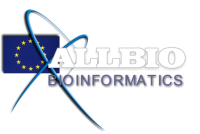
If you are interested in participating this Coordination Action please contact us!
There are still some places available for this tutorial:
Date: Saturday Sept 6, 2014 Place: Forum building of the Faculty of Medicine of Strasbourg Time: 9am – 5.30pm (registration starts from 8am)
Contact e-mail: mthomas@biologie.ens.fr
More details: http://www.eccb14.org/program/tutorials/cis-r
How to register: http://www.eccb14.org/registration
Registration includes lunch & coffee breaks on the day of the workshop and the tutorial material (.pdf and/or print). ECCB Tutorial rates: 110 € (academic) or 60 € (student)
This tutorial aims at introducing the theoretical principles and giving practical skills to use specialized software tools to extract motifs from full-scaled NGS datasets (typically covering tens of Mb).
Next Generation Sequencing led to the development of novel methods (ChIP-seq, FAIRE-seq, Clip-seq, ) to acquire massive data about diverse signals involved in genome regulation and function (cis-regulation, chromatin conformation, RNA maturation, recombination, replication, …).
Extracting relevant information from the raw data requires not only specialized software tools, but also a good understanding of their principles and parameters.
In this tutorial we will demonstrate how to analyze ChIP-seq data using the Regulatory Sequence Analysis Tools (RSAT, http://www.rsat.eu/), via their different ways of access: web-interface, command-line, and web-services.
This tutorial aims at introducing the theoretical principles and giving practical skills to use specialized software tools to extract motifs from full-scaled NGS datasets (typically covering tens of Mb).
The tutorial will be organized in 2 half days:
1) Analysis of cis-regulatory elements with the Regulatory Sequence Analysis Tools (RSAT): methods and website utilization (http://www.rsat.eu/).
2) Using RSAT in command-line and via web services (SOAP/WSDL).
Topics: - Motif discovery in NGS peak sets. - Impact of the background models. - Comparison between motifs. - Motif enrichment in peak sequences. - Evaluating the quality of motifs extracted from NGS peaks. - Building control sets to estimate the rates of false positives.
Other steps for the analysis of ChIP-seq data (e.g. read mapping, peak calling, functional enrichment of peaks, other tools for pattern discovery and matching).
The course is addressed to bioinformaticians and biologists. The afternoon will require being familiar with the Unix shell (Linux) and basic programming skills (Perl or Python) to implement clients for web services.
(https://cloud.france-bioinformatique.fr/) managed by Christophe Blanchet (IBCP, Lyon, France). Each participant will be given a (free) account to access this cloud and thereby a fully functional virtual machine with RSAT.
tutorial.
distribute protocols explaining the steps to solve selected test cases.
from the conference room to the servers.
This tutorial is funded by the ALLBIO project (http://www.allbioinformatics.eu/), whose goal is to establish the link between bioinformatics and biologist communities who express uncovered needs for other fields than human genomics (microbial, plant, livestock).